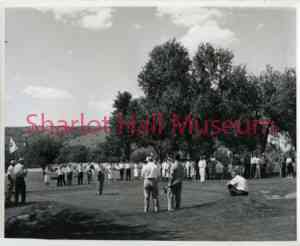By Worcester P. Bong
On November 19, 1919, the historic Hassayampa Country Club (now Capital Canyon Club) opened for the first time as a 2,820-yard, par 37, nine-hole golf course. But in July 1919, another little-known golf course for U.S. Army personnel, convalescing patients and other golf enthusiasts existed.
 The July 16, 1919 edition of the Weekly Journal-Miner announced a 2,809-yard, par 36, nine-hole golf course was built at the target range at Whipple Barracks. The target range (now Embry-Riddle Aeronautical University and Pioneer Park area) was roughly six miles north of Whipple Barracks. Conceived by Commanding Officer Bliss and Captain McNabb, the Whipple Barracks golf course was described as one of the “sportiest” links with an abundance of natural hazards. Prairie dog holes, brush, cactus and other numerous breaks in the ground made it difficult to play. Greens were constructed of special sand, oiled and rolled. An article titled “‘Fore’ instead of ‘Fire’ heard on Rifle Range” in the July 26, 1919 edition of The West’s Recall newspaper reported that transportation to and from the course was provided and golf clubs and balls were furnished.
The July 16, 1919 edition of the Weekly Journal-Miner announced a 2,809-yard, par 36, nine-hole golf course was built at the target range at Whipple Barracks. The target range (now Embry-Riddle Aeronautical University and Pioneer Park area) was roughly six miles north of Whipple Barracks. Conceived by Commanding Officer Bliss and Captain McNabb, the Whipple Barracks golf course was described as one of the “sportiest” links with an abundance of natural hazards. Prairie dog holes, brush, cactus and other numerous breaks in the ground made it difficult to play. Greens were constructed of special sand, oiled and rolled. An article titled “‘Fore’ instead of ‘Fire’ heard on Rifle Range” in the July 26, 1919 edition of The West’s Recall newspaper reported that transportation to and from the course was provided and golf clubs and balls were furnished.
When the War Department transferred operations of Whipple Barracks to the U.S. Public Health Service in 1920, the golf course and target range were no longer used. The land was turned over to the Bureau of Land Management (BLM). Portions of the land were later sold to the State of Arizona, Yavapai County, and the City of Prescott for recreational and public purposes.
When the Veterans Administration (VA) took over numerous hospitals in 1931, its mission was to provide rapid rehabilitation and healing for veterans with modern medical facilities. Around the early 1950’s, many newly built rural hospitals added athletic fields and golf courses in their open spaces. These features provided recreational and therapeutic activities for patients, as well as community special events for patients and the public. VA hospitals where golf courses were built in the 1950s included: Murfreesboro, Tennessee; St. Cloud, Minnesota; Chillicothe, Ohio; American Lake, Washington; Battle Creek, Michigan and Roseburg, Oregon.
A 1951 VA manual titled “Recreation Service” outlined procedures for maintaining golf activities at a VA  hospital. The manual stated the American Women’s Voluntary Services (AWVS) organization would promote the “Swing Club” program. Helen F. Lengfeld, golfer and founder of United Veterans Services, invented and developed the program. It was a golf program to help patients in Army and VA hospitals have healthy recreation with volunteer companionship. There were more than 60 “Swing Clubs” in VA hospitals around the country.
hospital. The manual stated the American Women’s Voluntary Services (AWVS) organization would promote the “Swing Club” program. Helen F. Lengfeld, golfer and founder of United Veterans Services, invented and developed the program. It was a golf program to help patients in Army and VA hospitals have healthy recreation with volunteer companionship. There were more than 60 “Swing Clubs” in VA hospitals around the country.
At the Prescott VA hospital, a six-hole golf course opened on September 6, 1961. Professional golf instructors from the Antelope Hills golf course visited the Prescott VA golf course on July 17, 1962.
 In the late 1980s, the Department of Veterans Affairs underwent cost realignment changes in treating veterans. Funding to operate and maintain golf courses at all VA facilities ceased. As a result, many golf courses on VA property were demolished or leased to city governments or private entities. In 1987, in order to make room for the construction of the Community Living Center at the Prescott VA, the last remnants of the six-hole golf course were demolished.
In the late 1980s, the Department of Veterans Affairs underwent cost realignment changes in treating veterans. Funding to operate and maintain golf courses at all VA facilities ceased. As a result, many golf courses on VA property were demolished or leased to city governments or private entities. In 1987, in order to make room for the construction of the Community Living Center at the Prescott VA, the last remnants of the six-hole golf course were demolished.
While the Whipple Barracks and Prescott VA golf courses no longer exist, we are blessed with a multitude of courses in the area, both public and private. Today’s modern maintenance techniques have eliminated the hazards of brush, cactus and prairie dog holes that golfers dealt with while playing the Whipple Barracks golf course.
“Days Past” is a collaborative project of the Sharlot Hall Museum and the Prescott Corral of Westerners International (www.prescottcorral.org). This and other Days Past articles are also available at archives.sharlothallmuseum.org/articles/days-past-articles/1 The public is encouraged to submit proposed articles and inquiries to dayspast@sharlothallmuseum.org Please contact SHM Research Center reference desk at 928-277-2003, or via email at archivesrequest@sharlothallmuseum.org for information or assistance with photo requests.


